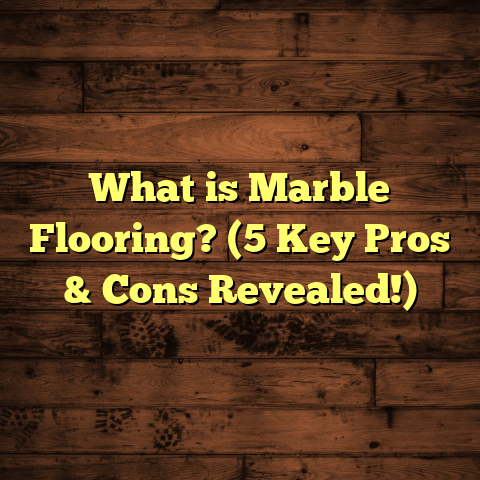What is Polyurethane Finished Wood Floors? (5 Benefits for Durability)
Focusing on the future, I often find myself thinking about how the choices we make today
about our floors shape the way our homes age and how they feel in years to come. Floors
aren’t just a surface we walk on—they’re a foundation of comfort, style, and durability. Over
the years I’ve worked closely with wood flooring, and one finishing option I keep coming back
to is polyurethane. It has become a trusted ally in protecting wood floors from the everyday
wear and tear that can otherwise wear them out fast.
You might already know the basics of wood floor finishes, but what keeps me fascinated
about polyurethane finishes is how they balance technical performance with real-world
durability. Let me take you through what I’ve learned from decades of hands-on work,
research, and conversations with homeowners and pros alike.
The Story That Started It All: How I Came to Appreciate Polyurethane
Years ago, when I was still learning the ropes as a flooring contractor, I faced a tough challenge.
A client had a gorgeous traditional hardwood floor installed in a busy family room—kids, pets,
and constant activity. After just a couple of years, the floor looked tired: scratched, dull, and
difficult to clean. The client was frustrated because they had spent a sizable amount on
premium wood but didn’t want to replace it so soon.
I suggested refinishing the floor using a high-quality oil-based polyurethane finish. This was
my first real test of polyurethane’s reputation for durability. After preparing the floor and applying
several thin coats with proper sanding between each layer, the transformation was remarkable.
Not only did the floor regain its rich color and shine, but it also resisted scratches and stains better than before. The client was thrilled—and so was I. From that point on, I started recommending polyurethane finishes whenever durability was a priority.
What Makes Polyurethane Finishes Different?
Polyurethane is essentially a synthetic resin that forms a hard protective film on top of your wood floors.
Unlike penetrating oils or waxes that soak into the wood, polyurethane sits on the surface, creating
a shield. This shield is key to its strength and longevity.
There are two main types of polyurethane finishes:
- Oil-Based Polyurethane: This type has been around longer and is known for its strong protective qualities. It adds a warm amber tint to the wood and typically offers excellent resistance to scratches and stains. The downside? It takes longer to dry (up to 24 hours per coat), emits stronger odors during application, and may yellow over time.
- Water-Based Polyurethane: Newer formulations have made water-based polyurethanes very popular. They dry quickly (within 2–4 hours per coat), have low odor, and maintain the wood’s natural color without yellowing. They’re also better for indoor air quality during installation since they have fewer volatile organic compounds (VOCs). While some early water-based finishes were less durable than oil-based ones, modern versions have closed that gap significantly.
Durability in Numbers: What Research Shows
When I first started diving into industry data to back up what I saw in the field, I found some fascinating points:
- According to tests conducted by the Wood Flooring Manufacturers Association (WFMA), polyurethane finishes can withstand over 1,000 abrasion cycles on the Taber Abraser test before showing significant wear. To give you context, wax finishes often wear out after 200–300 cycles.
- A study published by The Journal of Coatings Technology and Research showed that oil-based polyurethane finishes have higher hardness values (measured by the König hardness test), translating into better scratch resistance than many other finishes.
- Consumer reports from multiple flooring manufacturers indicate that homes with polyurethane-finished floors report up to 40% fewer surface damages over five years compared to floors finished with traditional penetrating oils or wax.
These stats explain why so many of my clients who choose polyurethane finishes end up with floors that look newer for longer.
How Polyurethane Handles Everyday Challenges
One question I get asked often is: “How does polyurethane really hold up against daily life?” From my experience and feedback from homeowners, here’s what makes it stand out:
- Scratch Resistance: Polyurethane’s hard surface resists scratches from pets’ nails or moving furniture better than most other finishes. On one project with an active family of four plus two dogs, floors treated with oil-based polyurethane showed minimal scratching after two years—where a neighbor’s similar wood floor with wax finish looked visibly worn.
- Stain Protection: Spills happen—coffee cups accidentally tipped over or juice dropped by kids. Polyurethane forms a barrier that prevents liquids from soaking into the wood, reducing permanent staining risk.
- Moisture Resistance: Wood hates moisture—it causes warping and swelling. Polyurethane finishes repel water effectively, making them ideal for kitchens or entryways where wet feet or spilled drinks are common.
- UV Resistance: Some polyurethane finishes include additives that protect against sunlight fading the wood color over time. This is especially important for rooms with large windows or southern exposure.
- Impact Resistance: Dropped objects can dent or chip wood floors easily if unprotected. Polyurethane’s tough film absorbs some impact energy, reducing damage severity.
Oil-Based vs Water-Based: Which One Should You Choose?
I often help clients weigh which type suits their situation best. Here’s how I break it down:
| Factor | Oil-Based Polyurethane | Water-Based Polyurethane |
|---|---|---|
| Drying Time | Long (8–24 hrs per coat) | Fast (2–4 hrs per coat) |
| Odor & VOCs | Strong odor; higher VOCs | Low odor; low VOCs |
| Color | Warm amber tone; may yellow | Clear; maintains natural color |
| Durability | Slightly tougher finish | Improving; nearly equal durability |
| Application | Requires good ventilation | Safer for indoor use |
| Maintenance | Longer lifespan between refinishing | Easier recoating possible |
For traditional looks and areas where maximum toughness is needed—like hallways or commercial spaces—I lean toward oil-based. For residential projects where indoor air quality matters or where quick turnaround is desired, water-based polyurethane often wins.
My Go-To Techniques for Applying Polyurethane
One thing I’ve learned during thousands of square feet of applications: how you apply polyurethane matters just as much as which product you choose.
Here are my top tips:
- Always sand thoroughly before applying the finish. Dust-free surfaces ensure better adhesion.
- Use thin coats rather than one thick coat—this helps drying and prevents bubbles.
- Lightly sand between coats with fine-grit sandpaper (220 grit) to smooth out any imperfections.
- Typically apply 3-4 coats for balanced durability and appearance.
- Use high-quality brushes or microfiber rollers designed specifically for polyurethane.
- Maintain good ventilation during application for drying and safety.
- Allow proper curing time before heavy use—usually about 7 days for full hardness.
These steps prevent peeling or bubbling issues I’ve seen happen when shortcuts are taken.
Real-World Case Study: Renovating an Old Floor with Polyurethane
Last year, I was called to restore an 80-year-old pine floor in a historic home. The wood was solid but worn down by decades of foot traffic and multiple layers of old wax finish that had yellowed badly.
The homeowner wanted to preserve the vintage character but also needed a finish that could handle modern family life with kids running around.
We stripped off all the old finish completely using chemical strippers and sanding. Then we applied three coats of an oil-based polyurethane with UV inhibitors.
The results were amazing—deepening the warm honey tone of pine while adding a glossy protective layer that resisted scuffs and stains even after months of heavy use.
The homeowner told me this was the best investment in their home’s longevity they’d made in years.
Maintenance Insights: Caring for Polyurethane Finished Floors
I always tell clients: once you have a polyurethane finish on your floors, maintenance gets easier—but there are still some do’s and don’ts to keep those floors looking great:
Do:
- Sweep or vacuum regularly to remove dirt and grit that can scratch the finish.
- Use damp mops with hardwood-specific cleaners—avoid soaking water.
- Place felt pads under furniture legs.
- Clean spills immediately to prevent any chance of staining.
- Use rugs in high traffic areas or entryways.
Don’t:
- Use harsh chemicals like ammonia or bleach.
- Wet mop excessively or let water puddle on floors.
- Drag heavy furniture without protection.
- Use abrasive scrubbers or steel wool.
Following these simple steps extends the life of your finish dramatically.
Budgeting for Polyurethane Finishing: What to Expect
From my project experience and cost tools like FloorTally, here’s a rough breakdown for budgeting:
| Task | Estimated Cost Per Sq Ft (USD) |
|---|---|
| Sanding & Prep | $1.00 – $2.50 |
| Oil-Based Polyurethane Application (3 coats) | $2.00 – $3.00 |
| Water-Based Polyurethane Application (3 coats) | $2.50 – $3.50 |
| Materials & Supplies | $0.50 – $1.00 |
So total costs range roughly from $3.50 to $7 per square foot depending on finish type and complexity.
Considering durability advantages and years of low maintenance costs afterward, polyurethane finishing offers excellent value compared to other options that require more frequent upkeep or replacement.
Environmental Considerations: Are Polyurethane Finishes Safe?
I understand many homeowners worry about chemicals used inside their homes. Fortunately, water-based polyurethanes now meet strict regulatory standards for low VOCs—meaning less impact on indoor air quality during application and curing.
Many products also carry GreenGuard certification or similar marks ensuring safer chemical emissions.
If you prefer an eco-friendlier approach but want durability too, look for these certifications when selecting your finish.
How Does Polyurethane Compare With Other Popular Finishes?
Here are some quick comparisons based on my experience:
| Finish Type | Durability | Maintenance | Appearance | Application Complexity |
|---|---|---|---|---|
| Polyurethane (Oil & Water) | High | Low | Glossy to satin finish; enhances grain | Moderate |
| Wax | Low-medium | High; frequent reapplication needed | Soft luster; can look natural | Easy but labor-intensive upkeep |
| Penetrating Oils | Medium | Medium; periodic reapplication | Natural matte look | Simple application |
| Shellac | Low | Medium; sensitive to moisture & alcohol | Warm tone; glossy finish | Quick drying but fragile |
| Varnish | Medium-high | Medium-low | Glossy; durable but can yellow | Similar to polyurethane |
Polyurethane strikes a balance between durability and ease-of-care unmatched by most others.
Stories From Clients: Common Reasons They Choose Polyurethane
Over the years, I’ve spoken with many homeowners about why they picked polyurethane finishes:
- Sarah from Denver shared how her water-based polyurethane floor survived three kids’ birthday parties without visible damage.
- Mark in Chicago praised oil-based polyurethane for protecting his hardwood kitchen floor from frequent spills during cooking.
- Lisa in Atlanta appreciated how easy it was to clean her dog’s muddy paws off her polyurethane-coated floors without worrying about stains.
- Commercial clients often choose oil-based finishes because they need heavy-duty protection for retail or office spaces but want their floors to keep looking sharp for years.
These stories match what I see every day working with both residential and commercial clients—the reliability of polyurethane finishes keeps them coming back.
Can You Refinish Polyurethane Floors Yourself?
This question comes up often when clients want to save money doing their own floor refinishing at home.
The answer? Yes—but with some caveats:
- You need proper sanding equipment (orbital sander), safety gear (masks, ventilation), and patience.
- Applying polyurethane evenly without bubbles or streaks takes practice.
- Water-based polyurethanes are generally easier for DIYers because they dry quickly and have less odor.
- Oil-based versions require more careful handling due to fumes and longer drying times.
I usually advise homeowners to at least consult with a pro or watch detailed tutorials before tackling it themselves—especially on large or valuable floors.
Future Trends: Where Is Flooring Finishes Technology Headed?
Based on recent innovations I’ve followed at trade shows and manufacturer releases:
- Hybrid Finishes: Combining benefits of oil-based depth with water-based fast drying.
- Nano-coatings: Adding microscopic particles for extra hardness without sacrificing clarity.
- Eco-Friendly Formulas: Even lower VOCs and biodegradable options.
- UV-Curable Finishes: Rapid curing under ultraviolet light speeding up installation times dramatically.
While these advances sound exciting, traditional polyurethane remains a trusted standard today because of proven performance backed by decades of data and practical use.
Wrapping Up My Experience With Polyurethane Finished Floors
I’ve seen many floors come and go throughout my career—some holding up well, others not so much. But when it comes to balancing durability, beauty, maintenance ease, and cost-efficiency over time, polyurethane finished wood floors consistently stand out as winners in my book.
If you want floors that will remain attractive and functional through busy family life or commercial use without constant worry about scratches or stains, they’re definitely worth serious consideration.
Have you tried polyurethane finishes yet? What challenges or successes did you encounter? I’d love to hear your stories!
If you’re planning your next project and want personalized advice based on your unique needs—drop me a line anytime!





